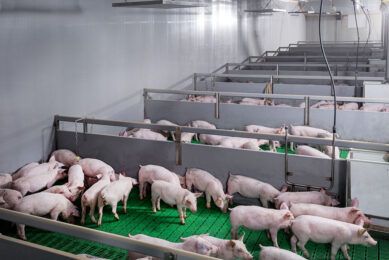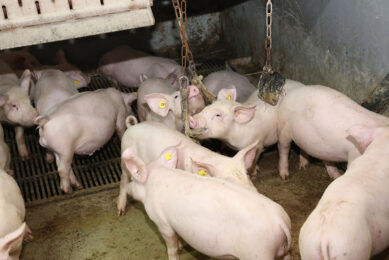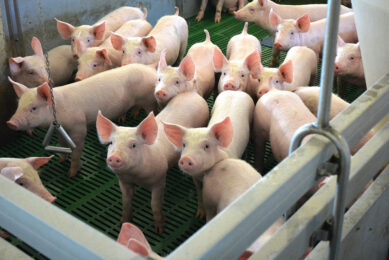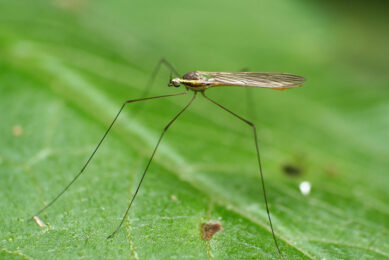What the textbooks don’t tell you about…Stress audits
Should you do a stress audit? Of course, but few people do. The textbooks do not mention it either. A stress audit is time put aside from normal duties by both the manager and section heads so as to…
1.Look at the pigs carefully, without distractions, to pick up abnormal behaviour.
2.Check on what devices (thermometers, sensors, controllers, fan speeds, air placement and fail-safe equipment, feed monitoring and delivery devices, water pressure etc.) to ensure the pigs are as comfortable as you can make them.
3. To see how well the staff are handling the pigs. For example, the female pig is vulnerable to unsympathetic handling during ovulation, insemination and implantation, when staff tend to be hurried as there is so much to be done in that busy month in the reproductive cycle.
Does it pay?
Clients tell me that a quarterly stress audit and acting on it has raised labour cost 3% to 5%. But the benefit of one person responsible for shipping 1,000 finishers achieving 8% faster throughput, and each sow producing half a piglet more born/ alive (from clients own figures 2008) will outstrip this extra cost sevenfold. Good value! (UK economic conditions 2010).
It should be done three or four times a year. Much can get out of kilter across four months.
Some experiences from 40 years of stress audits:
• Do it quietly, unobtrusively; so don’t wear white overalls – use green or blue.
• Observe the pigs unaware, under their normal behaviour patterns. Open nursery doors by 3 cm, no more, and listen for relaxed breathing or coughing, sneezing (I call it ‘snittering’, not quite the same), teeth grinding and general restlessness.
• If you need to switch on the light, then through the 3 cm gap, try to observe the resting pattern, huddling (piling) and where they are lying relative to the air pattern, which you can measure with a smoke candle / bee-keeper’s canister when you enter.
• A good time is last thing at night with a torch. Indeed Graeme Pope from Australia has suggested that a useful sign of them not getting enough food is to find them feeding in the middle of the night. Hunger stress.
• Next, observe them stirred up (best done during the day as they need nights rest just as we humans do). Walk down the building and, if you have a sensitive chest like me, breathing the atmosphere for gases – although encountering ‘stuffiness’ will do at a pinch – indicating attention to ventilation.• At the same time look for stiffness/ lameness – just after they all rise will make this much more apparent, as will lung/ respiratory trouble – coughing when disturbed.
• In nurseries and farrowing rooms, look for piglets which are lying awkwardly / lifting their bellies off the ground in the semi-sternum position. This can be advance warning of a digestive upset.
• In lidded kennels make sure all pigs are ‘banged-out’. Look at those last to leave carefully. Why are they reluctant/ sluggish?
• Use the farrowing crate to palpate (feel) the sows’ udders, using your fingers to reveal unusual conditions or discomfort to the sow.• Check hoppers and troughs for stale food, contamination, cleanliness and wastage. Good trough management is one of the major factors revealing the competence of the staff responsible or whether the manager is giving otherwise good workers enough time to do a good job! Rather too common.
• For stalled sows, get as many to stand as you can. Body-condition score those that do. Old-fashioned? No, because it makes you examine them properly. Go on to check legs. And ears – mange is more common than people think. Also body sores and think about how they happened.
• Water adequacy? Colour of urine should be white/ pale yellow, not towards orange. Constipation could be a sign, too.
• Check too much queueing at an ESF feed station. It can lead to anxiety-stress (Neural Endocrine System, or NES).
• Maintenance of floor quality – a task often postponed, thus needs a quarterly review to forecast when the area will next be vacated. Slipperiness, roughness, gaps, holes.
• Check that manipulable materials – straw, compost – are still adequate and not fouled. The same goes for toys (balls, pipes, bags, etc.) as pigs get bored with them. The experts change them once a month, if needs be by rotation.
Key stress signals
• Neonates: (Prolonged) aggression; excessive ‘wandering’ for food and comfort; late to suckle; lying away from heat source (too hot) or huddling (too cold); scuffed knees.
• Nursery: Competition; sore cleys; restlessness at night; crowding at trough (first few days).
• Gilts: Scrapping (insufficient fleeing space/overstocking); cold at night (huddling).
• Farrowing/ farrowed sow: Prolonged parturition; thirst; panting (too hot) or restlessness (too cold); food refusal (too hot); savaging (gilts); irritation/ rubbing (parasites); hot or ‘lumpy’ udders.
• Weaned sow: Lack of ‘feel-good’ factor (restlessness); if stalled – discomfort, especially cold; not enough food (especially fibre); legs and bursae (floors); parasites (head shaking/ chewing).
• In groups: Aggression, hesitancy, fear. Stiffness/ legs/ lameness/awkward gait; cold (on concrete).
• Growers/ finishers: Restlessness and vices (overstocking/ insufficient feeder space/ lack of sleep/ gases); variation in diurnal temperature; disturbed sounds at night (draughts); loading and movement stress (impatience and noise/ too steep ramps).
Join 18,000+ subscribers
Subscribe to our newsletter to stay updated about all the need-to-know content in the pigsector, three times a week. Beheer
Beheer










 WP Admin
WP Admin  Bewerk bericht
Bewerk bericht